Urban waterways
Contact
Introduction
The health of urban waterways is heavily influenced by urbanisation. Vegetation clearing, road and building construction, and polluting activities all increase the frequency and volume of polluted stormwater flowing into waterways and significantly degrade their health.
Water sensitive practices aim to protect and enhance urban waterways as an integral part of liveable cities.
Our research on urban waterways has identified some interesting findings:
- The dominant causes of change in urban waterway form are altered flow regimes and increased volumes of stormwater runoff. (Urban hydrogeomorphology and the urban stream syndrome: Treating the symptoms and causes of geomorphic change)
- A catchment-scale approach to managing waterway degradation should focus on managing the causes of degradation, like reducing flow, rather than the symptoms, like stabilising the channel. (Water(way) sensitive urban design: Addressing the causes of channel degradation through catchment-scale management of water and sediment)
- Urban stormwater runoff is a strong driver of species loss in streams, but riparian forests can likely increase a small number of tolerant macroinvertebrate families. (Interactive effects of urban stormwater drainage, land clearance, and flow regime on stream macroinvertebrate assemblages across a large metropolitan region)
- Improving waterway health by achieving natural flow regimes and improving water quality requires a mix of stormwater retention and infiltration measures at a range of scales. (Restoring natural flow regimes: the importance of multiple scales)
- Multi-functional constructed wetlands can be highly effective at both reducing nutrient loads and improving the ecological services of urban waterways through habitat and recreation. (A multi-functional, multi-compartment constructed wetland to support urban waterway restoration)
- Effective householder engagement in fostering stormwater retention aimed to protect urban streams requires an approach combining education to encourage review of subjective norms and attitudes, with incentives to mitigate behavioural controls to transform public behaviour towards sustainable stormwater management. (More than money: how multiple factors influence householder participation in at-source stormwater management)
- A study of the Swan Canning catchment-estuary system used simulated water and nutrient generation and export to predict nutrient loads under future land use and climate scenarios, and to scope potential future management changes through scenario testing. (Hydrological and nutrient modelling of the Swan Canning catchment-estuary system)
You will find a range of research reports on urban waterways under the categories below.
Waterway health
- Urban hydrogeomorphology and the urban stream syndrome: Treating the symptoms and causes of geomorphic change
- Water(way) sensitive urban design: Addressing the causes of channel degradation through catchment-scale management of water and sediment
- Interactive effects of urban stormwater drainage, land clearance, and flow regime on stream macroinvertebrate assemblages across a large metropolitan region
- Restoring natural flow regimes: the importance of multiple scales
- Hierarchical multi-taxa models inform riparian vs. hydrologic restoration of urban streams in a permeable landscape
- Using multi-tracer inference to move beyond single-catchment ecohydrology
- Are our urban streams on fire? Using studies on fire to learn about the Urban Stream Syndrome
- Will it rise or will it fall? Managing the complex effects of urbanization on base flow
- Another reason urban streams are stuffed: geomorphic history, challenges and opportunities
- Water(way) sensitive urban design: Addressing the causes of channel degradation through catchment-scale management of water and sediment
- Improving urban stream condition by redirecting sediments: A review of associated contaminants
- The performance of rainwater tanks for stormwater retention and water supply at the household scale: an empirical study
- Flows that cause geomorphic change in urban streams and what stormwater control measures can do
- Setting stream naturalisation goals to achieve ecosystem improvement in urbanising greenfield catchments
- Preliminary evidence suggests freshwater turtles respond positively to an environmental water delivery during drought
- Flow‐mediated movement of freshwater catfish, Tandanus bostocki, in a regulated semi‐urban river, to inform environments
- Improving urban stream condition by redirecting sediments: A review of associated contaminants
- Another reason urban streams are stuffed: geomorphic history, challenges and opportunities
- Hierarchical multi-taxa models inform riparian vs. hydrologic restoration of urban streams in a permeable landscape
Nutrient and pollutant control
- The impact of urbanisation on hydrology in areas with significant groundwater surface water interactions: Three case studies
- A multi-functional, multi-compartment constructed wetland to support urban waterway restoration
- Spatial and temporal characterization of nutrient net uptake in a vegetated urban stream: Stream bank features leading to net uptake hotspots
- Multi-scale characterisation of stream nutrient and carbon dynamics in sandy near coastal catchments of south-western Australia
- Soil microbes of an urban remnant riparian zone have greater potential for N removal than a degraded riparian zone
- Hydrological and nutrient modelling of the Swan Canning catchment-estuary system
Community engagement and leadership
- Setting stream naturalisation goals to achieve ecosystem improvement in urbanising greenfield catchments
- More than money: how multiple factors influence householder participation in at-source stormwater management
- More than money: how multiple factors influence householder participation in at-source stormwater management
- The performance of rainwater tanks for stormwater retention and water supply at the household scale: an empirical study
Research application
Our research on urban waterways has been applied to a range of projects, including:
- A residential development in Officer created a series of innovative water sensitive solutions including a low-flow creek system connected by sedimentation ponds, bio-sponge systems, drainage corridors and habitat ponds surrounded by public open space.
- Located in a heavily urbanised catchment, the Small Creek naturalisation project involved working with the community to remove 1.6 km of concrete channel, to slow flows and improve water quality and habitat for local flora and fauna.
- The Enhancing Our Dandenong Creek Program delivers a range of waterway improvement projects including daylighting a piped section of Dandenong Creek, creating new fish habitats, installing public amenities and working with industry to control pollution.
- The Scrubby Creek pilot application demonstrates application of the RESTORE Tool at four sites along Scrubby Creek to repair the waterway and identify opportunities for improvement.
Tools and guidelines
Several tools and guidelines, informed by our research on urban waterways, have been developed for use by practitioners:
- The RESTORE tool helps identify the ecosystem components to deliver the best ecological results for restoration of urban waterways.
- The accompanying factsheets for improving the ecological function of urban waterways guide the design and repair of different ecological components of waterways including flow, geomorphology, riparian, connectivity, water quality and biota.
- The riparian design guidelines identify 10 ecological processes performed by riparian zones, how these processes are stressed by urbanisation, how they can be repaired and a framework for prioritising on-ground action.
- This framework provides guidance on improving waterway health through a cost effective mix of incentives and regulation to reduce nitrogen and phosphorus emissions.
Infographics
Infographic 1
The early concept plan for Gum Scrub Creek, showing a Growling Grass Frog pond, bio- sponges, and lateral fingers (CRC for Water Sensitive Cities, 2017. A new community at Officer case study. Melbourne, Australia: CRC for Water Sensitive Cities, p. 14.)
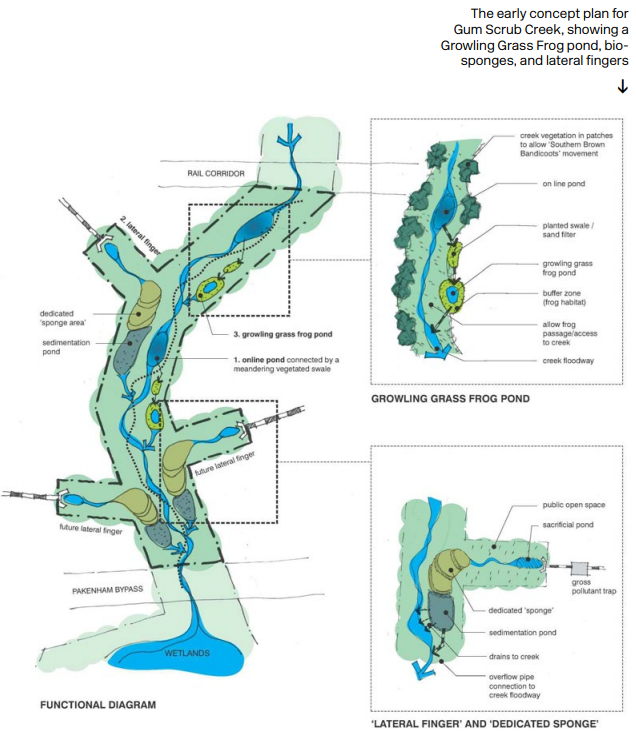
Infographic 2
Outlines Landscape Architecture (CRC for Water Sensitive Cities, 2017. A new community at Officer case study. Melbourne, Australia: CRC for Water Sensitive Cities, p. 16.)
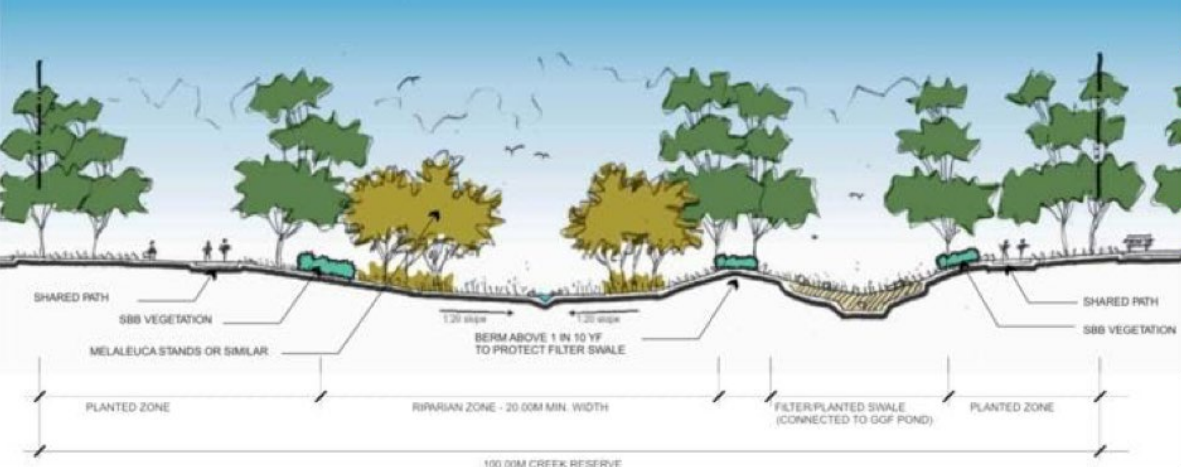
Infographic 3
Visualisation of the improved Gum Scrub Creek, including adjacent bio-sponge areas (CRC for Water Sensitive Cities, 2017. A new community at Officer case study. Melbourne, Australia: CRC for Water Sensitive Cities, p. 18.)
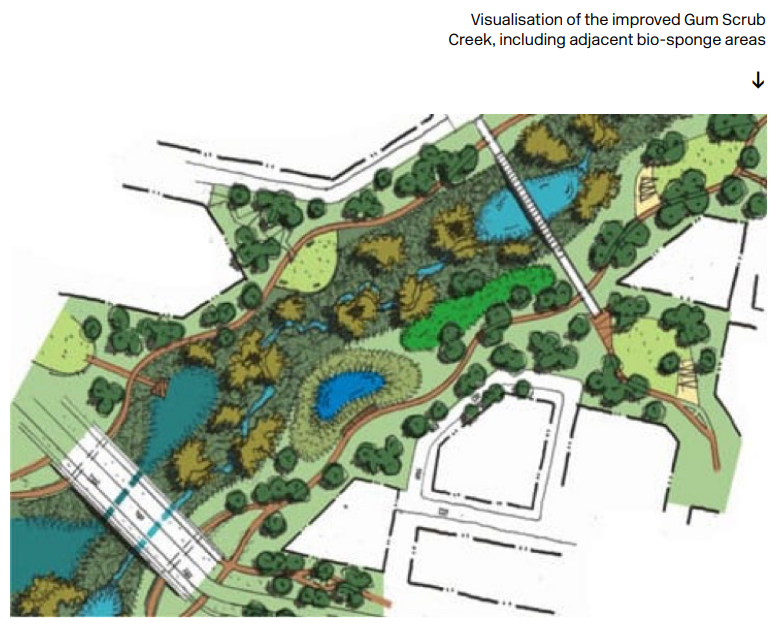
Infographic 4
Variation in the condition of urban riparian zones (Beesley et al., 2017. Riparian design guidelines to inform the ecological repair of urban waterways. Melbourne, Australia: CRC for Water Sensitive Cities, p. 7.)
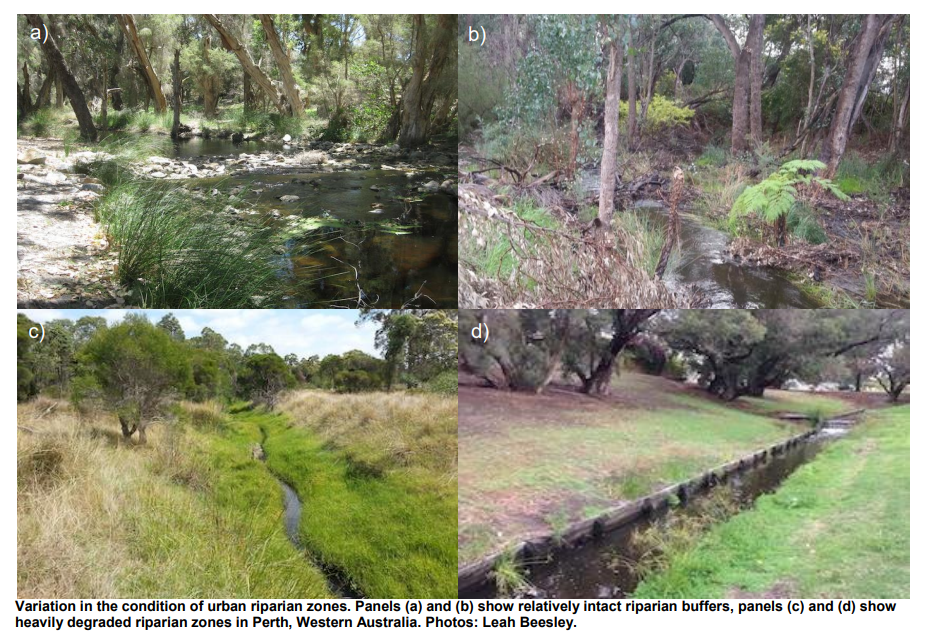
Infographic 5
Riparian attributes and the aquatic and terrestrial ecological functions they support (Beesley et al., 2017. Riparian Design guidelines to inform the ecological repair of urban waterways. Melbourne, Australia: CRC for Water Sensitive Cities, p. 9.)
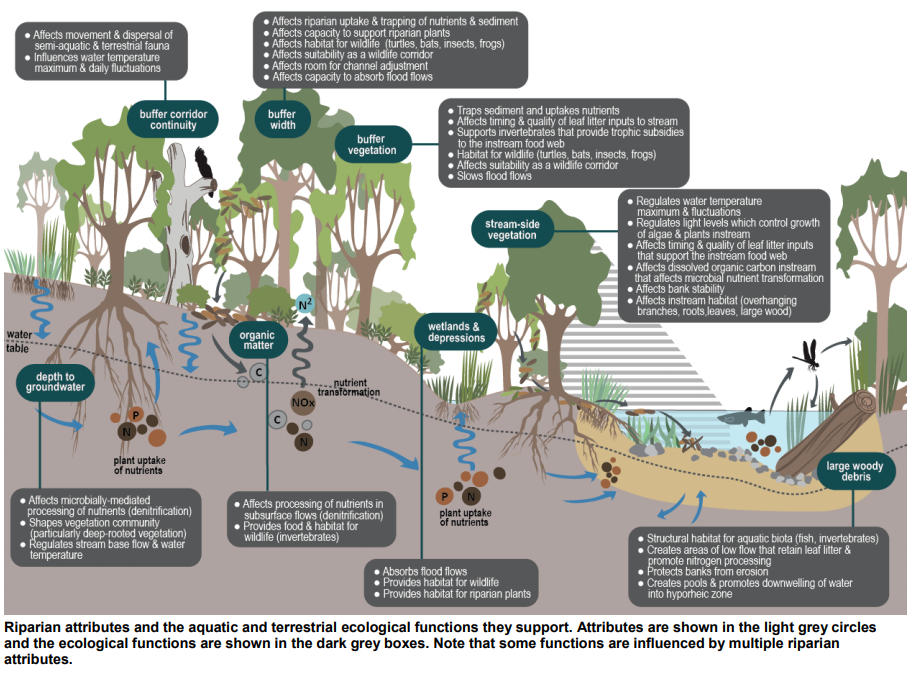
Infographic 6
A conceptual depiction of how key urban threats (shown in teal polygons) degrade the ecological processes that support healthy waterway functioning (Beesley et al., 2017. Riparian Design guidelines to inform the ecological repair of urban waterways. Melbourne, Australia: CRC for Water Sensitive Cities, p. 19.)
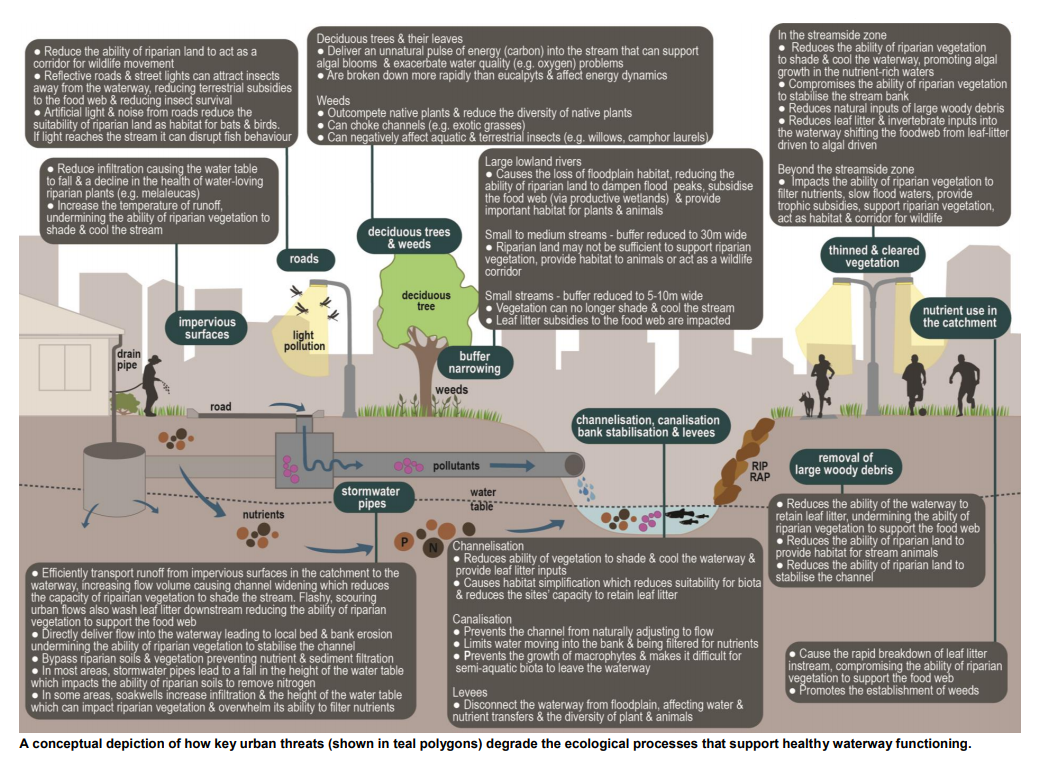
Infographic 7
A synthesis of our understandings of urban impacts on the landscape, atmosphere and hydrology and the benefits of stormwater harvesting and WSUD (Wong et al., 2013. blueprint2013 – stormwater management in a water sensitive city. Melbourne, Australia: CRC for Water Sensitive Cities, p. 42.)
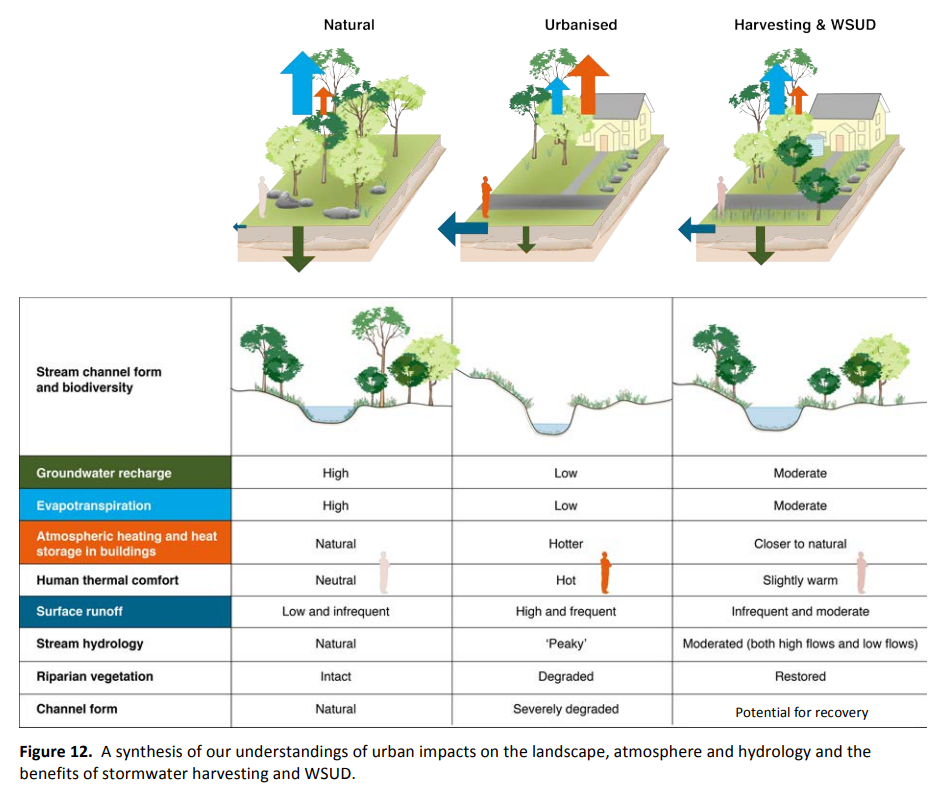
Infographic 8
Urban water cycle management delivers value to communities in multiple ways (CRC for Water Sensitive Cities, 2016. Ideas for the greater Darwin region. Melbourne, Australia: CRC for Water Sensitive Cities, p. 16.)
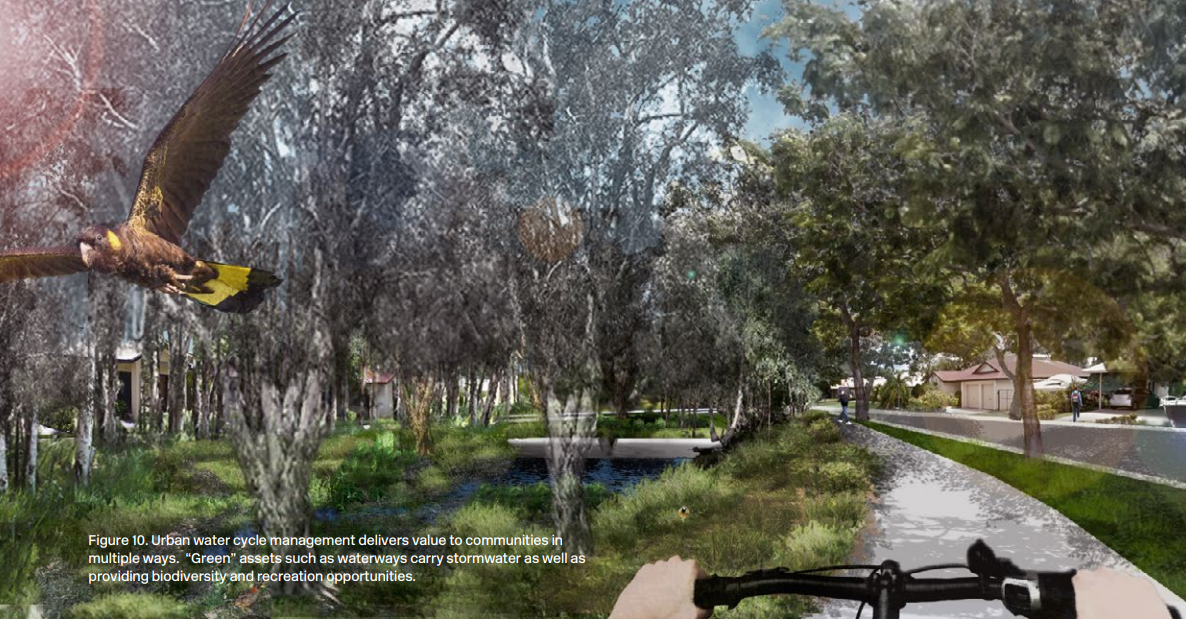
Infographic 9
A framework for assessing and implementing on-ground management actions to improve the ecosystem function of urban freshwater streams (CRC for Water Sensitive Cities, 2014. Protection and restoration of urban freshwater ecosystems: informing management and planning. Melbourne, Australia: CRC for Water Sensitive Cities, p. 2.)
